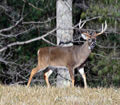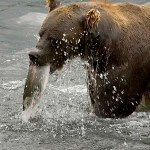Editor’s Note: If the South has another winter like the last couple of ones, southern hunters and perhaps other deer hunters across the U.S. will have to change their deer-hunting tactics. Or, they’ll continue to eat and sleep more in their deer stands. What do you do when the woods have too-much food in them, and the temperatures climb high causing the deer to refuse to move? Many deer hunters below the Mason-Dixon Line have faced this problem the last couple of years, with scientists reporting that winter has lasted 3 fewer weeks than usual across the U.S.
Hunters know they may be able to talk deer out of thickets due to the deer’s curiosity and its social nature. However, sitting in the same tree stand all morning and afternoon while blowing a grunt call won’t get the job done. Instead, consider using a run-and-gun tactic. Carry a portable tree stand that you’ve learned how to climb quietly with you. Also take a turkey call with you. As you approach a thicket you want to call to, take three steps, scratch in the leaves with the toe of your boot, cluck and purr like a hen, and then take three more steps. Use raccoon urine on your boots as a cover scent. While you walk slowly through the woods scratching, purring and occasionally soft clucking, you’ll sound like a turkey, a natural sound that won’t alarm a deer that’s bedded-down.
 As you start to climb a tree, climb as slowly as possible, making sure no metal clangs against metal. Once in your tree stand, begin to give grunts, and rattle lightly. You want to sound like a couple of young bucks sparring on the edge of the bedding area. Also change your grunt call to give the sound of a doe as well as that of young bucks. Then the deer in the thicket will assume that there’s several deer just outside the bedding area. Throw the sound of your grunt call to either side of the tree and behind the tree where you’re set-up to sound as though you’re moving. After 20 minutes of calling, if you haven’t seen a buck, begin to give bleats, a sound that both does and fawns make. Often a bleat call will bring in a buck when a grunt call won’t. After another 20 to 30 minutes of calling, come out of your tree stand, put the stand on your back, and walk, while clucking and purring like a turkey hen. Travel 150 to 200 yards to another thick spot, and repeat the same sequence of calling.
As you start to climb a tree, climb as slowly as possible, making sure no metal clangs against metal. Once in your tree stand, begin to give grunts, and rattle lightly. You want to sound like a couple of young bucks sparring on the edge of the bedding area. Also change your grunt call to give the sound of a doe as well as that of young bucks. Then the deer in the thicket will assume that there’s several deer just outside the bedding area. Throw the sound of your grunt call to either side of the tree and behind the tree where you’re set-up to sound as though you’re moving. After 20 minutes of calling, if you haven’t seen a buck, begin to give bleats, a sound that both does and fawns make. Often a bleat call will bring in a buck when a grunt call won’t. After another 20 to 30 minutes of calling, come out of your tree stand, put the stand on your back, and walk, while clucking and purring like a turkey hen. Travel 150 to 200 yards to another thick spot, and repeat the same sequence of calling.
 When deer don’t want to move, you must get close to them to try to coax them out of their beds. But the closer you get to deer, especially older-age-class bucks, the more you must watch the wind and the noise you make going to the bucks. If you hunt into the wind, sound like a turkey walking and smell like a big coon when in a tree, you won’t spook as many deer and may encourage bucks to come out and investigate your calling. I also use Scent Kapture products https://scentkapture.com/ before my hunt – the spray, the clothes detergent, the body and hair wash and the field wipes on myself and my tree stand to encapsulate odors and eliminate them.
When deer don’t want to move, you must get close to them to try to coax them out of their beds. But the closer you get to deer, especially older-age-class bucks, the more you must watch the wind and the noise you make going to the bucks. If you hunt into the wind, sound like a turkey walking and smell like a big coon when in a tree, you won’t spook as many deer and may encourage bucks to come out and investigate your calling. I also use Scent Kapture products https://scentkapture.com/ before my hunt – the spray, the clothes detergent, the body and hair wash and the field wipes on myself and my tree stand to encapsulate odors and eliminate them.
To learn more about hunting deer with John E. Phillips’ Amazon Kindle eBooks, print books and Audible books (the latest Audible is “How to Hunt Deer Like a Pro”) and Nook books, click here at https://johninthewild.com/books/#deer. You can type in the name of the book and download it to your Kindle, and/or download a Kindle app for your iPad, SmartPhone or computer. For a free download on how to make jerky from venison to provide a protein-rich snack, choose “How to Prepare Venison Jerky: The Ultimate Snack Food” at johninthewild.com/free-books.
















